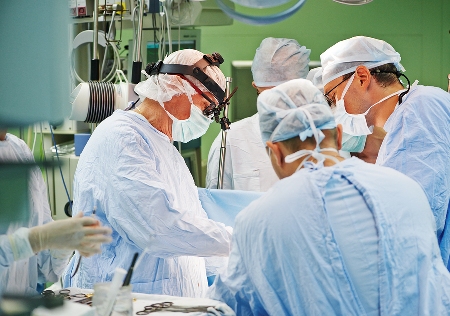Winners
Scientific research services
The MRFF will enter the industry, funded by health savings. The federal government is targeting an increase in the MRFF’s capital level to $20.0 billion from 2014-15 through 2018-19. The MRFF will pay annual dividends to fund medical research, with the dividend expected to rise to $500.0 million in 2019-20. The additional funding will provide a significant revenue injection into an industry that IBISWorld estimates will be worth $4.9 billion in 2019-20.
In contrast, however, $111.4 million will be removed from the CSIRO’s budget over the next four years as part of $146.8 million of cuts to scientific research. Cuts to other scientific research will cause the industry to flounder in 2014-15 and 2015-16 as the MRFF is being capitalised.
Technical and vocational education and training
The federal government will remove the 20 per cent loan fee applied to VET FEE- HELP loans, which are provided to eligible full-fee paying students in higher level vocational education and training.
Removing the loan fee on VET FEE- HELP loans will strengthen demand for vocational qualifications, as it will significantly reduce applicable repayments. With more full-fee paying students enrolled in the vocational education system, IBISWorld expects that the industry's revenue will grow strongly over the next five years.
Losers
General hospitals
Under the National Health Reform Agreement 2011, the federal government was to fund 45.0% of efficient growth for general hospitals from 2014-15 through 2016-17, then 50.0 per cent of efficient growth from 2017-18 onwards. Efficient growth is growth in the volume of services, with every service given an efficient price as determined by the Independent Hospital Pricing Authority.
The federal government has reneged on $16.4 billion of funding guarantees under the National Health Reform Agreement, as well as efficient growth provisions to occur from 2017-18. From 2017-18, the federal government will distribute funding to the states based on CPI and population growth. In 2017-18, funding will decrease by $1.2 billion, with further decreases in the following years expected to put downward pressure on industry revenue if the states are unable to make up the shortfall.
General practice medical services, pathology services, and diagnostic imaging services
From 1 July 2015, Medicare schedule fees for GP consultations, diagnostic imaging services and pathology services will be reduced by $5, with patients having to make $7 co-payments. The federal government is expected to achieve its aim of reducing demand from patients that do not require GP attention. IBISWorld expects that the loss of about $1.2 billion in annual funding will not be off by patient co-payments, as lower demand will have a negative net eff on industry revenue over the next five years.
Demand for diagnostic imaging and pathology services will be similarly affected as patients avoid visiting their GPs. IBISWorld expects that demand for these services after a GP has referred patients will remain stable despite further $7 co-payments being required, as these are generally more essential health services.
- Suppliers
- New to MedicalSearch? Book a Demo
- Advertise with us
- Login
- Email Marketing
- Buyers
- Get Quotes
- Articles & Ideas
- Login
- Subscribe to newsletter
- My Details
- Get Quotes
- Accident & Emergency Care
- Aged Care & Disability
- Anaesthesia & Respiratory Care
- Beauty & Wellness
- Cardiology & Cardiac Surgery
- Dental Care & Oral Surgery
- Diagnostic Instruments & Medical Imaging
- Disinfection & Sterilisation
- ENT & Audiology
- Gynaecology & Obstetrics
- Homecare & Consumer Medical
- Hospital Equipment & Supplies
- Intensive Care Unit
- Laboratory & Pathology
- Medical Apparel
- Medical Devices & Products
- Medical Fridges & Freezers
- Medical Storage & Filing
- Medical Waste Management
- Optometry & Ophthalmology
- Orthopaedics & Podiatry
- Paediatrics & Neonatology
- Patient Monitoring & Management
- Physiotherapy & Rehabilitation
- PPE & Infection Control
- Single Use Medical Consumables
- Surgical Tools & Supplies
- Treatment Beds, Tables & Couches
- Veterinary Equipment
- Wheelchairs & Mobility Aids
- Get Quotes
- Accident & Emergency Care
- Aged Care & Disability
- Anaesthesia & Respiratory Care
- Beauty & Wellness
- Cardiology & Cardiac Surgery
- Dental Care & Oral Surgery
- Diagnostic Instruments & Medical Imaging
- Disinfection & Sterilisation
- ENT & Audiology
- Gynaecology & Obstetrics
- Homecare & Consumer Medical
- Hospital Equipment & Supplies
- Intensive Care Unit
- Laboratory & Pathology
- Medical Apparel
- Medical Devices & Products
- Medical Fridges & Freezers
- Medical Storage & Filing
- Medical Waste Management
- Optometry & Ophthalmology
- Orthopaedics & Podiatry
- Paediatrics & Neonatology
- Patient Monitoring & Management
- Physiotherapy & Rehabilitation
- PPE & Infection Control
- Single Use Medical Consumables
- Surgical Tools & Supplies
- Treatment Beds, Tables & Couches
- Veterinary Equipment
- Wheelchairs & Mobility Aids
Trusted by 500,000+ Australian medical buyers
Buyers
- Discover products & solutions
- Login
- Subscribe To Newsletter
- Browse All Products
- Read Articles
Suppliers
Advertise
- Promote your products & solutions
- New to MedicalSearch? Book a Demo
- Login / Forgot Password
- Advertise Your Products
- Success Stories
- Email Marketing
- Suppliers
- Advertise with us
- Login
- Email Marketing
- Buyers
- Get Quotes
- Articles & Ideas
- Login
- Subscribe to newsletter
- My Details
Get Quotes
- Accident & Emergency Care
- Aged Care & Disability
- Anaesthesia & Respiratory Care
- Beauty & Wellness
- Cardiology & Cardiac Surgery
- Dental Care & Oral Surgery
- Diagnostic Instruments & Medical Imaging
- Disinfection & Sterilisation
- ENT & Audiology
- Gynaecology & Obstetrics
- Homecare & Consumer Medical
- Hospital Equipment & Supplies
- Intensive Care Unit
- Laboratory & Pathology
- Medical Apparel
- Medical Devices & Products
- Medical Fridges & Freezers
- Medical Storage & Filing
- Medical Waste Management
- Optometry & Ophthalmology
- Orthopaedics & Podiatry
- Paediatrics & Neonatology
- Patient Monitoring & Management
- Physiotherapy & Rehabilitation
- PPE & Infection Control
- Single Use Medical Consumables
- Surgical Tools & Supplies
- Treatment Beds, Tables & Couches
- Veterinary Equipment
- Wheelchairs & Mobility Aids
Get Quotes
- Accident & Emergency Care
- Aged Care & Disability
- Anaesthesia & Respiratory Care
- Beauty & Wellness
- Cardiology & Cardiac Surgery
- Dental Care & Oral Surgery
- Diagnostic Instruments & Medical Imaging
- Disinfection & Sterilisation
- ENT & Audiology
- Gynaecology & Obstetrics
- Homecare & Consumer Medical
- Hospital Equipment & Supplies
- Intensive Care Unit
- Laboratory & Pathology
- Medical Apparel
- Medical Devices & Products
- Medical Fridges & Freezers
- Medical Storage & Filing
- Medical Waste Management
- Optometry & Ophthalmology
- Orthopaedics & Podiatry
- Paediatrics & Neonatology
- Patient Monitoring & Management
- Physiotherapy & Rehabilitation
- PPE & Infection Control
- Single Use Medical Consumables
- Surgical Tools & Supplies
- Treatment Beds, Tables & Couches
- Veterinary Equipment
- Wheelchairs & Mobility Aids
Trusted by 500,000+ Australian medical buyers





